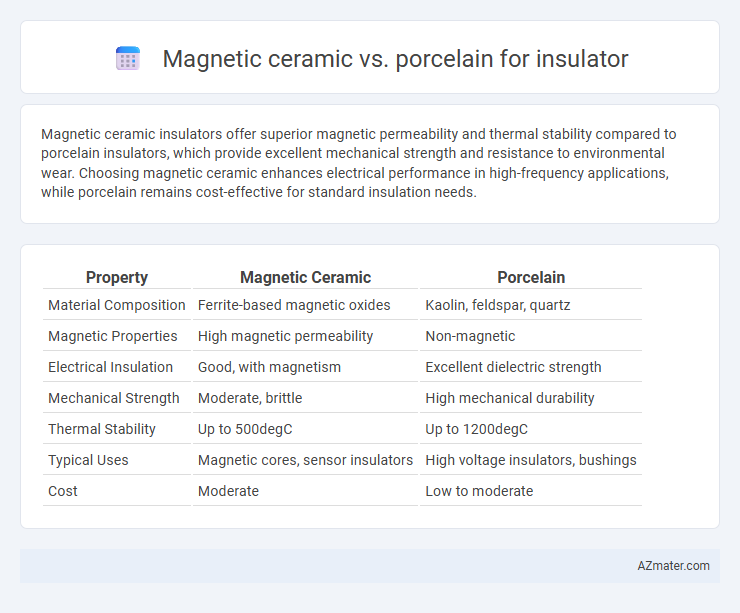Magnetic ceramic insulators offer superior magnetic permeability and thermal stability compared to porcelain insulators, which provide excellent mechanical strength and resistance to environmental wear. Choosing magnetic ceramic enhances electrical performance in high-frequency applications, while porcelain remains cost-effective for standard insulation needs.
Table of Comparison
| Property | Magnetic Ceramic | Porcelain |
|---|---|---|
| Material Composition | Ferrite-based magnetic oxides | Kaolin, feldspar, quartz |
| Magnetic Properties | High magnetic permeability | Non-magnetic |
| Electrical Insulation | Good, with magnetism | Excellent dielectric strength |
| Mechanical Strength | Moderate, brittle | High mechanical durability |
| Thermal Stability | Up to 500degC | Up to 1200degC |
| Typical Uses | Magnetic cores, sensor insulators | High voltage insulators, bushings |
| Cost | Moderate | Low to moderate |
Introduction to Electrical Insulators
Electrical insulators such as magnetic ceramics and porcelain play a critical role in preventing undesired current flow in high-voltage power systems. Magnetic ceramics offer superior mechanical strength and improved thermal stability compared to traditional porcelain insulators, making them suitable for demanding electrical environments. Porcelain insulators remain widely used due to their excellent electrical insulating properties and cost-effectiveness but exhibit lower resistance to mechanical shock and environmental degradation.
Overview of Magnetic Ceramic Insulators
Magnetic ceramic insulators, primarily composed of ferrite materials, offer superior magnetic permeability and high electrical resistivity, making them ideal for applications requiring efficient electromagnetic interference suppression and signal isolation. Unlike porcelain insulators, which are valued for their mechanical strength and weather resistance, magnetic ceramics excel in low-loss magnetic performance and thermal stability in high-frequency environments. Their unique combination of magnetic and insulating properties enables advanced usage in transformers, inductors, and microwave devices where both insulation and magnetic functionality are critical.
Overview of Porcelain Insulators
Porcelain insulators, made from alumina and kaolin clay, exhibit high mechanical strength and excellent electrical insulation properties, making them ideal for high-voltage applications. Their ceramic structure provides superior resistance to weathering, thermal shock, and contamination, ensuring long-term reliability in outdoor environments. Porcelain insulators outperform magnetic ceramics by offering enhanced dielectric strength and mechanical durability essential for power transmission and distribution systems.
Key Material Properties Comparison
Magnetic ceramic insulators exhibit superior magnetic permeability and mechanical strength compared to porcelain, making them ideal for applications requiring enhanced electromagnetic performance. Porcelain insulators offer excellent dielectric strength and thermal stability, ensuring reliable insulation in high-voltage and high-temperature environments. The choice between magnetic ceramic and porcelain depends on specific electrical and mechanical requirements, with magnetic ceramics favored for their magnetic response and porcelains for their insulation reliability.
Electrical Performance Differences
Magnetic ceramic insulators exhibit higher magnetic permeability, enhancing electromagnetic interference (EMI) shielding and reducing signal loss compared to porcelain insulators, which have low magnetic permeability. Porcelain insulators provide superior dielectric strength and better resistance to surface contamination, making them ideal for high-voltage applications with minimal leakage current. The electrical conductivity of magnetic ceramics is generally higher, which can lead to increased dielectric losses, whereas porcelain maintains excellent insulation properties with stable performance under varying environmental conditions.
Mechanical Strength and Durability
Magnetic ceramics exhibit superior mechanical strength compared to traditional porcelain insulators, offering enhanced resistance to impact and mechanical stress in electrical applications. Their microstructural composition provides greater durability under thermal cycling and harsh environmental conditions, leading to longer service life. Porcelain insulators, while reliable, are more prone to cracking and mechanical degradation over time, making magnetic ceramics a preferred choice for high-performance electrical insulation systems.
Thermal and Environmental Resistance
Magnetic ceramic insulators exhibit superior thermal stability, maintaining structural integrity at temperatures above 1400degC, making them ideal for high-temperature electrical applications. Porcelain insulators offer excellent environmental resistance, including resistance to moisture, pollution, and UV exposure, which ensures long-term performance in outdoor settings. Both materials provide distinct advantages, with magnetic ceramics excelling in extreme heat conditions and porcelain delivering robust durability against environmental degradation.
Cost and Manufacturing Considerations
Magnetic ceramic insulators generally offer lower material costs compared to porcelain due to the use of more readily available raw materials and simpler manufacturing processes. Porcelain insulators require high-temperature firing and precise glazing techniques, leading to increased energy consumption and longer production cycles, which elevate manufacturing expenses. Cost-efficiency in magnetic ceramics is balanced by their sometimes lower mechanical strength, making porcelain preferable for high-stress applications despite its higher production costs.
Typical Applications: Magnetic Ceramic vs Porcelain
Magnetic ceramic insulators are commonly used in high-frequency transformers, inductors, and microwave components due to their superior magnetic permeability and dielectric properties, which enhance electromagnetic performance. Porcelain insulators are preferred in high-voltage power transmission and distribution systems for their excellent mechanical strength, weather resistance, and insulating capabilities under harsh environmental conditions. Magnetic ceramic materials excel in electronic and communication devices, while porcelain remains the standard for utility-scale electrical insulation in substations and overhead lines.
Conclusion: Choosing the Optimal Insulator
Magnetic ceramics offer superior dielectric strength and enhanced thermal stability compared to porcelain, making them ideal for high-performance insulator applications. Porcelain remains widely used due to its mechanical robustness and cost efficiency, especially in standard power distribution systems. Selecting the optimal insulator depends on balancing performance requirements, environmental conditions, and budget constraints, with magnetic ceramics favored for advanced technical needs and porcelain suited for conventional uses.

Infographic: Magnetic ceramic vs Porcelain for Insulator
 azmater.com
azmater.com